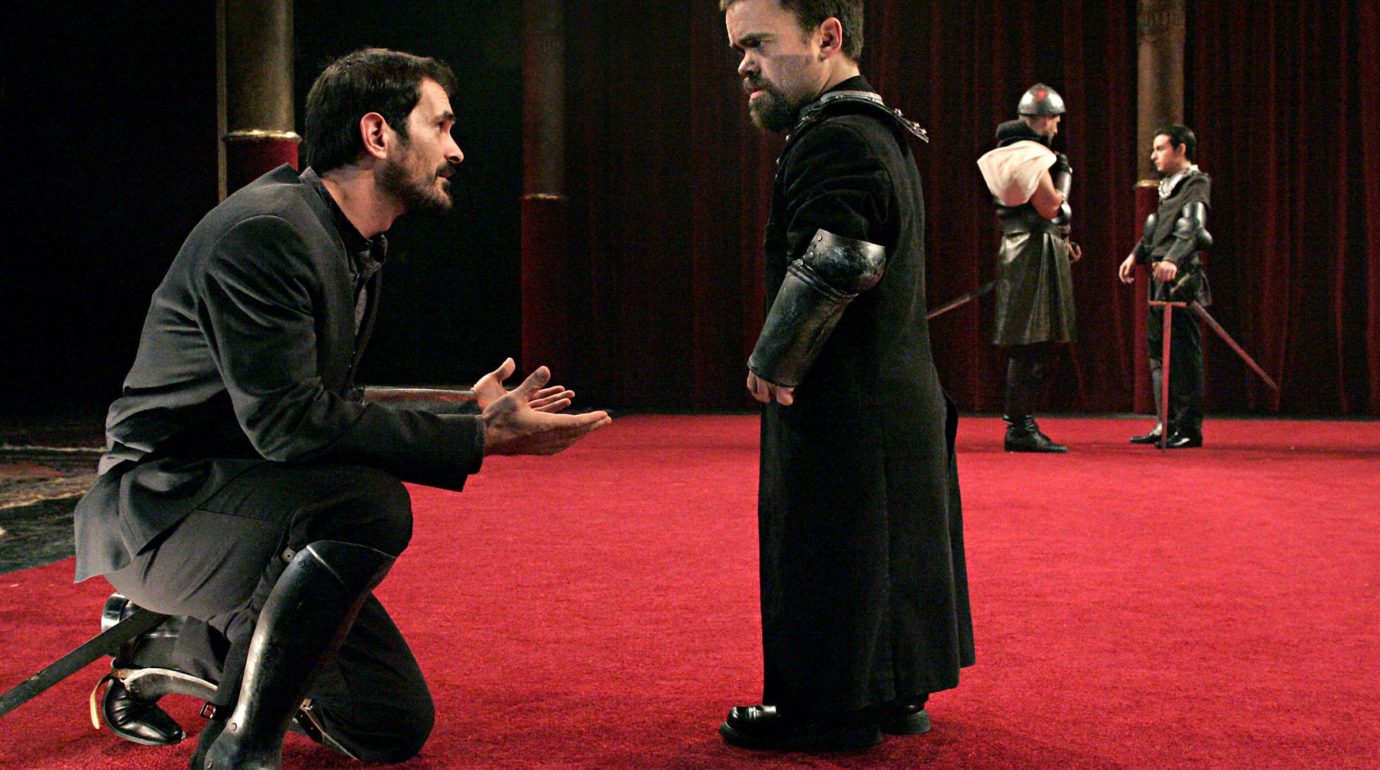Arthur Hughes playing Richard III for the Royal Shakespeare Company is the latest disabled actor to reclaim Shakespeare’s disabled character from a tradition of able-bodied actors “cripping up” to play disabled. Performances like Hughes’s illuminate the logic of “cripping,” a term of empowerment for acts that reconfigure stigmas associated with disability based on knowledge gained from disability activism and disability studies. The cripping of Richard III opens up discussions about the relationship between an actor’s and character’s identities while illustrating the recent push for fair hiring practices in theatre.
Cripping is distinct from “cripping up,” a tradition that stretches from Richard Burbage to Laurence Olivier, in which actors, though costumed in physical disability, bounded around the stage as Richard III with an energetic athleticism that rarely suggested mobility impairments. The portrayal of Richard only really became disabled in the 1980s with the rise of disability activism and disability studies as an academic discipline, though for some time he was still played by non-disabled actors.
The first major disabled Richard III was played by Antony Sher in the early 1980s in a Royal Shakespeare Company tour in England. As recounted in Sher’s memoir of the performance, Year of the King (1985), a few years before playing Richard, his Achilles tendon snapped during an accident onstage. His leg placed in a plaster cast for six months, Sher used arm crutches to walk, finding the experience frustrating. Those emotions came rushing back when he was cast to play Richard. He used his arm crutches, emphasizing the text’s description of a “bottled spider.” Drawing a distinction between the “deformity” that characterizes Richard in Shakespeare’s text and disability as understood in the 21st century, Sher concluded: “I had set out to look for a physical shape, but maybe what I found is something about being disabled.”
Although Sher had experience with disability before his run as Richard, his casting still involved an able-bodied actor cripping up to play disabled. It took a second wave of disability activism—marked in the United States by the passage of the Americans with Disabilities Act in 1990 and in the United Kingdom by the Disability Discrimination Act in 1995—to inaugurate a new age in the casting of Richard III.
The Czech star Jan Potměšil played Richard in a wildly popular production in 2000 in Prague. A hot, young, rising actor in Czech theatre and film, Potměšil was injured in a 1989 car accident during the Velvet Revolution. His Richard III juxtaposed historically specific medieval costumes and sets with his modern wheelchair, swapped at times for a palanquin throne or a horse moved by an able-bodied actor hidden under the saddle.
In October 2001, the Nouveau Theatre Experimental in Montreal, Quebec, staged Dave Wants to Play Richard III in the basement of the Sainte-Justine Children’s Hospital. With the patients upstairs in mind, audiences saw Dave Richer, an actor with cerebral palsy who uses a wheelchair, adapt Shakespeare’s play into a reflection on the relationship between a disabled actor’s body and the English language’s most famous disabled character. In one account, “The focus for the spectator is not so much what the lines are saying but how they are made to read on Dave’s body.”
When Kathryn Hunter played Richard in 2003 at the Globe, a woman playing a man put the intersection of disability-based stigma and gender-based stigma on display. Walking with a limp, her right arm askew because it was once reset improperly after a break, Hunter was motivated by a sympathetic reading of Richard’s disability: “By finding his heart and his mind and what drives him, I hope we’ll begin to see how the disabled person can be unreasonably maligned and marginalized, and then begin to see Richard as a complex human being rather than a cursed person whose external deformities explain his inner evil.”
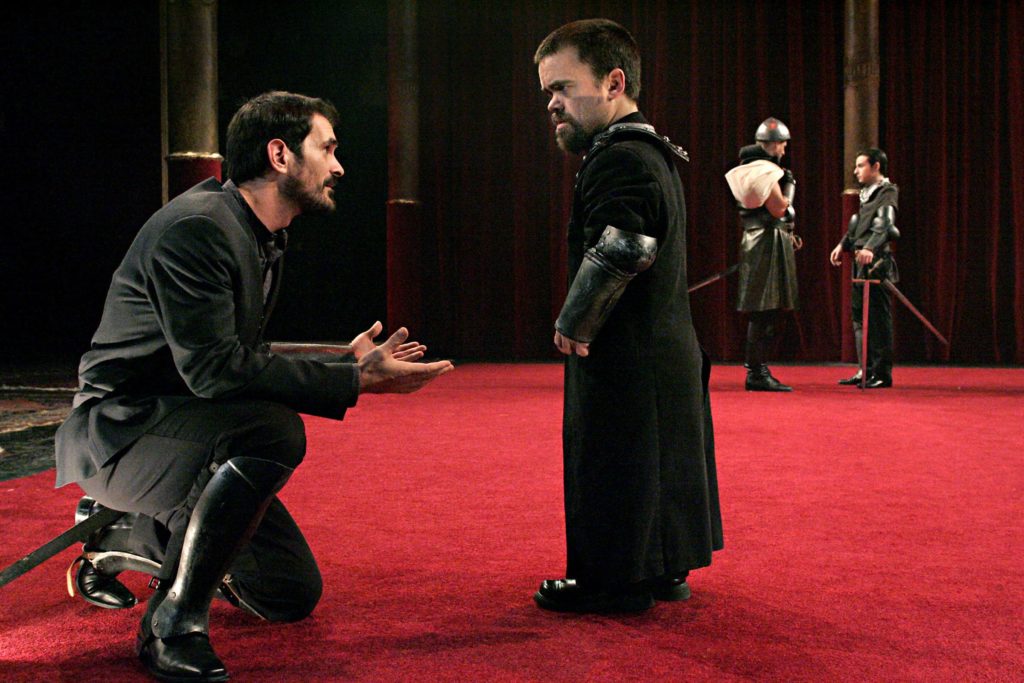
Ty Burrell and Peter Dinklage in “Richard III,” 2004. (Photo from The Public Theater)
Peter Dinklage’s 2004 performance as Richard at the Public Theater in New York saved an otherwise flat production. In a fascinating approach, Dinklage explained to director Peter DuBois that society’s impulse not to stare at people with disabilities—to turn away, to pretend one doesn’t see them—allows someone like Richard III to get away with things when people aren’t looking.
The invisibility of people with disabilities in everyday life was also a central concern for Henry Holden, who played Richard III in 2005 at the Spoon Theatre in New York. Holden’s Richard was an exhausted employee in the workplace who grew increasingly frustrated with day-to-day discrimination.
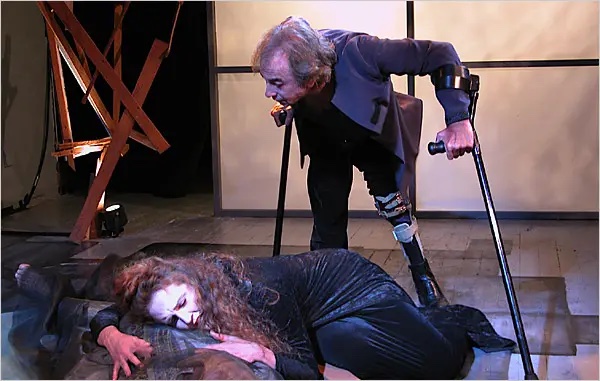
Holden’s crutches were swapped for Rene Moreno’s wheelchair in a 2008 Richard III at the Kitchen Dog Theatre in Dallas. Moreno’s only requirement for the role was that the set be ADA-compliant, except for a small staircase that Moreno couldn’t climb, meant to indicate Richard’s sense of exclusion. Like Holden, Moreno’s performance was informed—in his portrayal of the character and in press coverage of the production—by his experience working in a theatre industry often unwelcoming to people with disabilities.
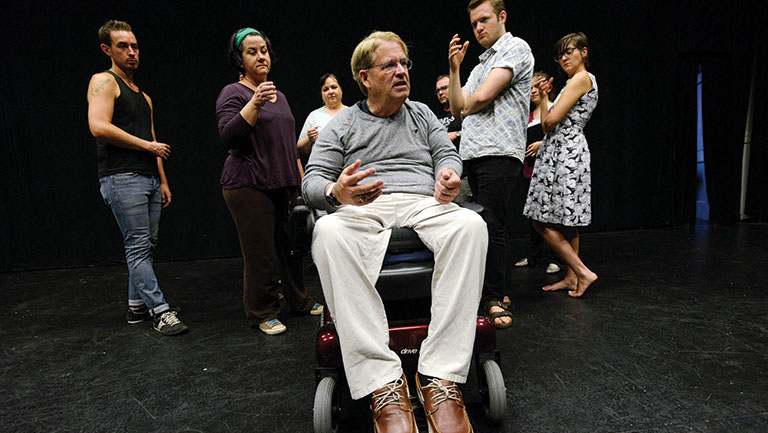
Stephen Madigan performed Richard, also in a wheelchair, in an amateur 2015 production at the Portland Stage Company in Maine. Not a professional actor but a practicing doctor, Madigan wanted to inspire people with disabilities to achieve success. Perhaps this was not earth-shattering theatre, but it was life-affirming for him and many in his audience.
The tone was not triumphant but indignant in a 2016 Richard III in Winnipeg staring Debbie Patterson, which was advertised as “a disability revenge play.” Her Richard was not sinister but “justifiably resentful.”
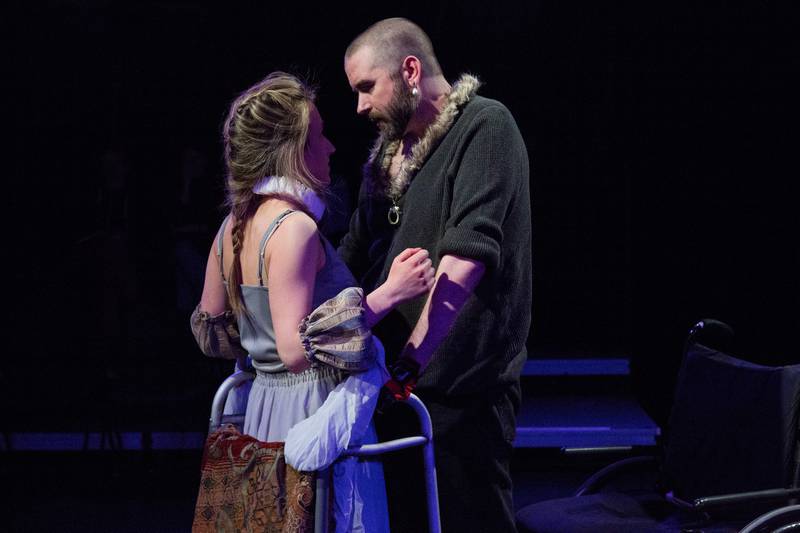
Michael Patrick Thornton could use a walker but preferred a wheelchair, which is how his Richard appeared onstage in a 2016 production at the Steppenwolf Theatre in Chicago. He pinned his enemies in his walker, symbolizing Richard’s willingness to use disability to gain leverage over his enemies. In the scene of his coronation, Thornton’s Richard employed a ReWalk exoskeleton procured from a partnership with the Rehabilitation Institute of Chicago—a robotic suit allowing Richard to stand and walk, so that physical ability represented Richard coming into power.
The discovery of Richard’s skeleton in 2012 led Australian actor Kate Mulvany to play the role for the Bell Shakespeare Company in 2017. “I saw his skeleton on TV and it was like looking at an X-ray of my own spine,” Mulvany said, referring to cancer treatments she underwent in childhood. “I have the same condition as Richard, severe scoliosis. I know exactly the kind of pain he suffered.”
These themes culminated in Mat Fraser’s Richard III at the Hull Truck Theatre in the U.K. in 2017. Fraser saw himself as an ambassador for disabled actors, and press coverage of his Richard III was filled with his calculated anger over the lack of disabled actors in mainstream media: “Every single theatre in Britain should be able to answer yes to the question: Have you employed one disabled actor in the last year? If the answer to that question is no, then the theatre should hang its head in shame and know that it is a relic of the past.” From this angle, the most inspired casting in Richard III at Hull wasn’t Fraser as Richard; it was Dean Whatton, an actor with dwarfism who doubled as one of the young princes and one of Richard’s murderers—roles that don’t call for disability.
When the Royal Shakespeare Company cast Arthur Hughes in 2022, the headline in the Guardian was “‘There’s a truth to it’: RSC Casts Disabled Actor as Richard III.” The motive behind the cripping of Richard III in recent years, however, is not simply that a disabled actor can connect with and portray Shakespeare’s disabled king better than an able-bodied actor. If we see this attitude as the aesthetic motivation behind the cripping of Richard, the political motivation has exerted more force: A disabled actor playing Richard III exemplifies the recent push for fair hiring practices in the English-speaking world.
Every time an able-bodied actor plays Richard, that’s one less role available for a disabled actor. Since disabled actors are less likely to be cast in roles for able-bodied characters, employment opportunities are limited. This dynamic has the look and feel of structural discrimination on the basis of disability, which laws and standards since the 1990s have sought to curb. In the main, having disabled actors play Richard III isn’t about offering a radically new interpretation of the play or even a better, more realistic performance; it’s about enhancing the visibility and status of disabled actors in the hopes that they will secure more roles, including roles for characters that don’t have disability as a centerpiece. The political goal of disabled actors is to bring the way the world looks and feels onstage closer into line with reality. This means having disabled actors portraying characters in stories about disability, as well as disabled actors playing characters in stories having nothing to do with disability.
The political motives behind the cripping of Richard III are most fully present not in performances of Shakespeare’s play but in adaptations, which activate the aesthetic motives for cripping Richard by infusing a “nothing about us without us” disability sensibility into the artwork from its inception.
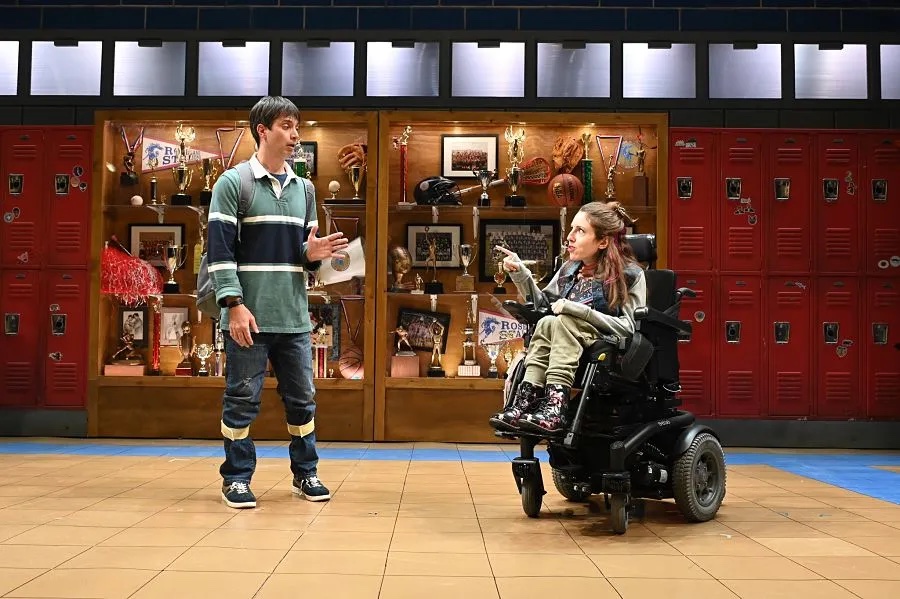
In 2012, Gregg Mozgala—founder and artistic director of the Apothetae, a New York theatre company exploring the disabled experience—commissioned Mike Lew to write an adaptation of Richard III set in an American high school. A proponent of Asian American theatre, the able-bodied Lew saw parallels between barriers to disability in the theatre world and racist exclusions he had experienced himself. A note at the start of their play—with its un-Google-able title, Teenage Dick—doesn’t mince words: “Cast disabled actors for Richard and Buck. They exist and they are out there. Also cast diverse actors.”
Similarly, richard III redux, written by Kaite O’Reilly and Phillip Zarrilli and first performed by Sara Beer in 2018, is “a one-woman show about Richard III from a disability perspective, performed by someone with the same physicality as the historical Richard.” O’Reilly’s political motives are strategic, precise, and explicit: “As a counter to the tradition of ‘cripping up’ in Shakespeare’s Richard III, we offer the rights to this text solely to the atypical performer: those who identify as disabled.” Ultimately, richard iii redux reveals the inseparability of the political and aesthetic motives of cripping and the priority of the political: Casting people with disabilities is necessary for an accurate dramatic representation of the disability experience.
Jeffrey R. Wilson (he/him) is the author of three books, Richard III’s Bodies from Medieval England to Modernity: Shakespeare and Disability History (2022), Shakespeare and Game of Thrones (2021), and Shakespeare and Trump (2020). His work putting Shakespeare in conversation with modern culture has appeared on CNN, NPR, MSNBC, New York Times, Salon, JSTOR Daily, Zocalo Public Square, Academe, CounterPunch, and The Chronicle of Higher Education. On Twitter @DrJeffreyWilson.

